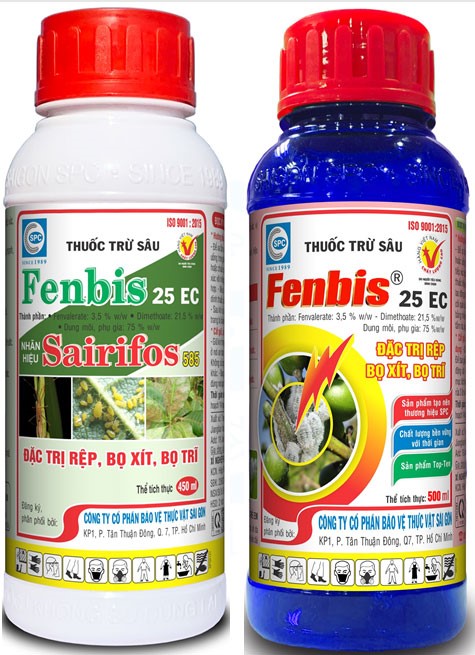|
FENBIS 25EC INSECTICIDE
21/06/2023
FENBIS 25EC INSECTICIDE Ingredients: Fenvalerate 3.5% w/w + Dimethoate: 21.5%w/w Fenbis 25EC is an EC ( Emulsifiable concentrate )form, containing 3.5% Fenvalerate (Pyrethroid) and 21.5% Dimethoate (organic phosphorus), broad spectrum of action, strong odor, light brown color, inhibitory action. Acetylcholineestase (AchE) is a neurotransmitter that causes an insect to die immediately when it hits the product. The product has contact, toxic taste, strong absorption ability and repels insects. Fenbis 25EC prevents many types of leaf-eating worms, stem borers and plant-sucking pests, especially very effective against mealybugs and harmful spiders. Due to the mixture of two strong insecticides, which are quickly absorbed by plant tissues, mixed in appropriate proportions, promoting and enhancing the insecticide effectiveness of each active ingredient, the prevention spectrum is therefore expanded and effective. Fast and powerful insecticide effect even on difficult to treat and product resistant pests. Fenbis 25EC belongs to toxic group II, moderately toxic to humans, livestock and natural enemies, toxic to bees and fish. P.H.I : 7-14 days. Fenbis 25EC can be mixed with many other pesticides and diseases except Bordeaux solution, alkaline products and fertilizers.
Note: Amount of water sprayed: 400 - 800 liters of water/ha. Spray early when worms just appear, spray carefully where pests hide and cause harm, should be sprayed early in the morning or in the cool late afternoon, do not spray when the tree is flowering. In Vietnam, this mixture is registered to control many objects such as spodoptera litura , leaf rollers, rice bugs, diamond back moth , green caterpillars, leaf miners (miners), aphids on melons, vegetables, army worms , fruit borers, bean aphids, sugarcane aphids, leaf-eating worm , cotton aphids, mosquito bugs, green hoppers on coffee green , on black pepper, miners , aphids, red spiders on fruit trees
|
To prevent, in addition to plowing and burying weed seeds, collecting weed stalks and stumps left after tilling the land to burn, not letting weeds produce seeds in production fields, etc., the use of chemical products is still a measure. optimal because of its ability to thoroughly kill weeds, reduce labor and take advantage of more time than manual weeding.
Miner has the scientific name Phyllocnistis citrella Staint., family Phyllocnistidae, order Lepidoptera. The miner occurs in many countries in the tropics and subtropics. The main host of the miner is the citrus family - Rutaceae. In addition, the miner also attacks mangosteen and some other plants.
Adult is a small planthopper, with a body 2-3 mm long, the whole body is ash gray, slightly greenish, the wings are opaque with many small brown spots.Eggs are oval, 0.3 mm long, have a pointed end and are attached directly to the leaf surface, leaf axils.
Green bugs specialize in the fruit of citrus groups (oranges, tangerines, lemons, grapefruits, kumquats...), some people call them orange bugs, or orange suckers. Their scientific name is Rhynchocoris poseidon or Rhynchocoris humeralis.
In Vietnam, yellow leaf curl disease is very common on papaya trees, especially the disease is often severe in areas of high and continuous planting, areas with hot and arid climates. The disease has significantly reduced the yield and quality of papaya. Gardens that are infected early when the plants are young may not yield. However, up to now, many gardeners still do not know the cause and how to fix it.
Spider mites are common pests on citrus trees, especially in hot and dry climates that are suitable for spiders to grow and cause severe damage.The group of harmful spiders is usually very small in size, unlike the natural enemy spiders.
This group includes species that are generally very small in size, causing damage by sucking plant sap (on leaves, fruits, branches, stems).
There are many species of mealybugs present on the group of Oranges,Tangerines,Grapefruits and Lemons (Citrus), which can be divided into 2 groups:
+ Group of sticky mealybugs with common varieties such as Lepidosaphes, Aonidiella, Coccus and Saissetia.
+ Group of flower mealybugs with common genera and species such as Pseudococcus, Planococcus and Icerya purchasi.
Dry branches and berries disease often appear to be common damage on coffee gardens during the rainy season. The disease causes death of branchs, dry fruit, severely affects the canopy structure and coffee yield if not paid attention to prevention.
Pink disease commonly causes diseases on rubber plantations in the rainy season, especially on garden from 4-8 years old. This year, rubber has to go through a period of severe drought, weakening the tree, so now in tnshe rainy season it is easy to get infected. Therefore, it is necessary to pay attention to good management to avoid affecting the garden.
In recent years, the area of citrus has been expanded because it is a fruit tree with high economic efficiency. However, in order to sell at a high price, not only in quality but consumers also require the external beauty of the fruit, so pest management on citrus is a matter of great concern to farmers. The hot season is a favorable condition for thrips to develop and cause damage, affecting the commercial value of fruit.
- Headquarters
- SAIGON PLANT PROTECTION JOINT STOCK COMPANY
- RQ 1, Nguyen Van Quy St., Tan Thuan Ward, HCM City
- Tax code: 0300632232
- Tel: (028) 38 733 295 - 38 732 077
- Fax: (028) 38 733 003 - 38 733 391
- Website: www.spchcmc.vn - Email: info@spchcmc.vn
- SAIGON PLANT PROTECTION COMPANY
- SAIGON PLANT PROTECTION JOINT STOCK ENTERPRISE
- Lot C1-C3 Hiep Phuoc Industrial Park, Hiep Phuoc Commune, HCM City
- Tel: (028) 3873 4089 - Fax: (028) 3873 4086
- Affiliated Unit
-
- Quick Links
- Home
- About us
- Career Opportunities












